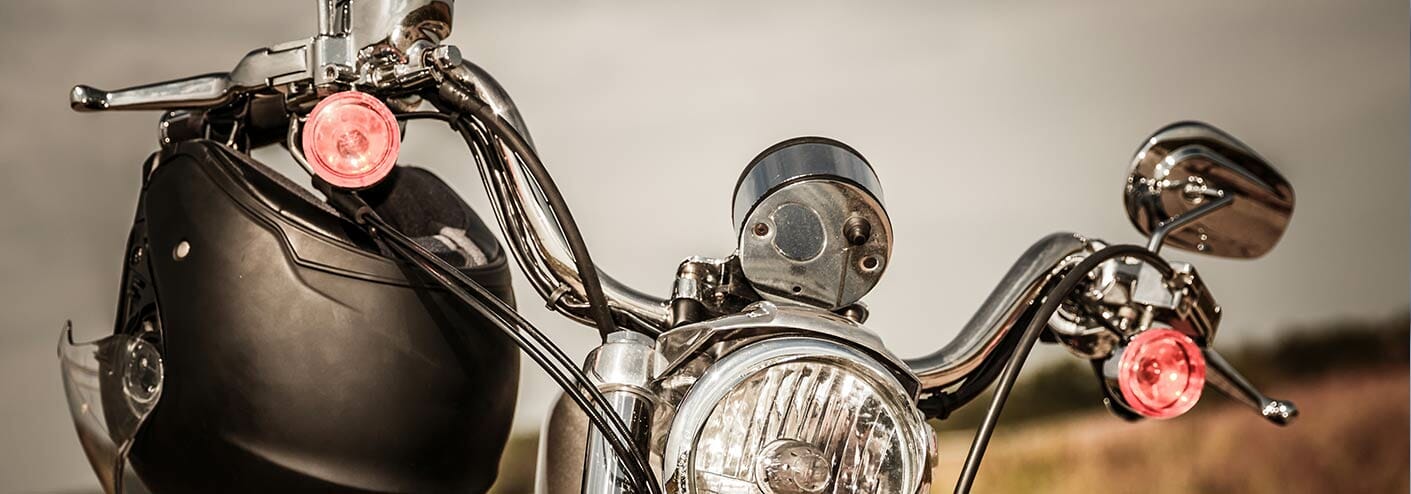Why Motorcycle Safety Is So Important
Our Attorneys Know Motorcycle Accidents Too Well
The motorcycle seems a quintessentially American invention. In truth, dozens of designs outfitting a standard bicycle with an internal combustion engine developed across Europe in the late nineteenth century. But it wasn’t until World War II ended that American motorcycles became linked with the qualities of independence, freedom and rebellion. Veterans formed motorcycle clubs as a way of coping with returning to civilian life. After one rally was exaggerated by the media as a riot, the idea of bikers as trouble was born. The juvenile delinquent biker depicted in the 1953 classic film The Wild One morphed into the outlaw motorcyclist portrayed in the 1969 landmark movie Easy Rider.
Many bikers have embraced that image. Despite a host of different styles to choose from, one of the most enduringly popular is the classic American cruiser with its big engine, loud pipes and shiny chrome. So dominant is the cruiser style that just about every foreign manufacturer has at least one model in its line. Regardless of whether a bike is classified as a cruiser, a touring bike or a sport bike, they are all fundamentally two wheels with no cage to protect the operator. Fender benders on a motorcycle are rare. More commonly, when a car hits a motorcyclist, there is direct vehicle-to-human contact.
According to the National Highway Traffic Safety Administration, 88,000 motorcyclists were injured and nearly 4,700 motorcyclists died in crashes in 2013, the last year for which complete statistics are available. Per vehicle mile traveled, motorcyclists were 26 times more likely to be killed in an accident than car drivers or passengers.
The Insurance Institute for Highway Safety reports that 42 percent of motorcyclist deaths in 2013 occurred in single-vehicle crashes, 58 percent occurred in multiple-vehicle crashes and 91 percent of motorcyclists killed were males.
Despite the dangers, U.S. motorcycle sales grew from 465,783 in 2013 to 483,526 in 2014, an increase of 3.8 percent, according to preliminary figures from the Motorcycle Industry Council. More than 8.4 million motorcycles are registered in the United States. California, Texas and Florida have the most motorcyclists by volume, likely due to their mild winters and coastal routes. Kentucky has over 98,400 registered motorcycles and a population of 4.3 million people, resulting in a ratio of 44.1 people per motorcycle.
Motorcycle enthusiasts maintain there is nothing that compares to the feeling of riding “cageless.” It’s an argument that easily captures the imagination of those who haven’t done it. Who wouldn’t like to feel the open air on their face while casually rolling along? Of course, that fantasy involves ideal conditions – a sunny day, a paved road in good condition, few (if any) other vehicles and absolutely no jeopardy of being hurt or killed. The reality is that such freedom often comes at a high price, and although you may be willing to take the risk, there are some things you can do to help yourself from becoming a statistic.
When You Ride
For starters, consider the time of day and time of year that you are riding. Forty-nine percent of motorcyclist deaths in 2013 occurred on weekends, and those deaths were more likely to occur after 6 p.m. compared with weekdays. Sixty-two percent of motorcyclist deaths in 2013 occurred from May to September. Fatalities peaked in August and were lowest in February and December. Typically, the first rides of the season can also be the most dangerous, when streets are coated with winter grit that makes for treacherous turning, motorists have spent 4 to 6 months without seeing bikes on the road, and bikers’ skills have diminished from inactivity. Being extra cautious during these time periods might be enough to keep you out of the ER.
Respect the Machine
It’s also important to respect the design of the machine you are riding. There has been much debate in the motorcycle community about what type of bike is the safest. Some argue that sport bikes accelerate and brake better than cruisers do, allowing them to maneuver out of hazardous situations more easily. Others argue that cruisers are harder to miss because they are louder, run better in rainy conditions due to the heavier engines and have additional protective barriers in the form of fenders. According to the Insurance Institute for Highway Safety, sport bikes have the highest death rates among all types of motorcycles. That’s not a surprise, considering that sport bikes are built to be street-legal race bikes and appeal to those who tend to want to push limits. Regardless of type, the responsibility is in the hands of the rider, not the machine. Dangerousness boils down to the choices people make when they ride.
Take a Class
Whether you have never taken a class or haven’t in years, consider attending a Motorcycle Safety Foundation (MSF) riding course. The MSF is a nonprofit organization supported by motorcycle manufacturers, with classes held across the country. Several courses aimed at varying skill levels are offered, all designed to provide opportunities to practice and develop safe riding habits. Basic courses help new riders be less overwhelmed when they finally hit the road solo, intermediate courses offer new techniques to enhance the riding experience and refresher courses help with forgotten or neglected skills. There are even financial incentives — select insurance companies give discounts for completing a class, while some motorcycle manufacturers offer refunds or discounts on a new bike.
Ride Sober
Another no-brainer is following DUI laws. Fifty-five percent of motorcycle drivers killed from 9 p.m. to 6 a.m. in 2013 had blood alcohol content (BAC) levels at or above the state limit of 0.08 percent. The MSF estimates that even the least amount of alcohol increases a rider’s chance of crashing five times. And a (still potentially legal) BAC over 0.05 percent increases chances to crash 40 fold. Among other side effects, alcohol can influence safe driving skills by impairing vision, reducing reaction times, diminishing concentration, causing drowsiness and losing short-term memory. Decreased abilities, which a person cannot adequately judge, combined with a lessened sense of inhibition, may also yield an increased sense of (false) confidence. Tragically, motorcycle riders involved in fatal crashes in 2013 were found to have the highest percentage of alcohol-impairment than drivers of any other vehicle type.
Protect Your Skull
Mandatory helmet use is an issue about which informed people can and do disagree. While this article isn’t intended to further the debate about motorcycle helmets, when you are arguably the most vulnerable vehicle on the road, you need all the tools you can get to stay safe. Many argue that helmets are uncomfortable, ineffective, and that riders can better see and hear what’s going on around them without one. Helmets are estimated to be about 37 percent effective in preventing motorcycle deaths and about 67 percent effective in preventing brain injuries, yet only 19 states mandate helmet use by all riders. When it comes to the southern states, Kentucky, South Carolina and Florida are the only ones that have a partial helmet law.
Kentucky had a universal helmet law for 30 years. It was repealed in 1998 and changed to require helmets only by those operators under 21, those riding on learning permits or those who have had a license for less than one year.
Motorcycle fatalities increased by more than 50 percent after the law was repealed. In 2014, there were 1,275 motorcycle injuries and 76 fatalities in Kentucky. Of those injured, 688 were not wearing a helmet, while 46 of those who were killed were helmetless.
Studies have shown that helmeted motorcyclists suffer fewer neck injuries when they crash compared to riders who crash without helmets, likely due to the energy-absorbing qualities of a DOT motorcycle helmet. The simple act of putting on a helmet may make a difference in that it reminds the rider of the potential danger he or she is about to embark upon. A good helmet can make the ride more comfortable by cutting down on wind noise in your ears, windblast in your eyes and bugs on your face. There is also an economic impact to consider — in 2010, an estimated $3 billion in medical, productivity and insurance costs was saved as a direct result of helmet use. An additional $1.4 billion could have been saved if all motorcyclists had worn helmets. In states with a universal helmet law, an average of $725 per registered motorcycle was saved, which is nearly four times greater than in states that do not have such laws ($198 saved). The evidence points to the conclusion that a helmeted motorcyclist who gets into a collision has a better chance of surviving than one who is not wearing a helmet.
General Tactics
Try to ride as if nobody driving a car or truck sees you. Never assume the right of way. When you see another vehicle on the road, ride as if they will do the one thing they should not do, such as pull out in front of you, cross into your lane, run the red light, or rear end you as you slow or stop. Learn to yield, even when it is your right not to do so. Plan ahead and always leave yourself an escape route. Wear bright colors, especially on your helmet and jacket. Run your high beam during the day. Make an effort to ride in or move to a location where drivers with potentially conflicting courses can see you before they stray in your direction. Learn to roll off the throttle because sometimes, it’s best to drop back rather than try to ride around or race past another vehicle.
New “Dead Red” Law
Effective July 15, 2015, Kentucky joins 14 other states in adopting a law that allows motorcyclists to drive through red lights in certain circumstances. Intended to keep motorcyclists from being struck from behind or struck while waiting for a light to change, a motorcyclist facing a steady red light can enter or cross the intersection if the person establishes all of the following conditions:
- The motorcycle was brought to a complete stop;
- The traffic control signal continued to show a steady red light for 120 seconds or the traffic control signal at the intersection has completed two lighting cycles;
- The traffic control signal was apparently malfunctioning or, if programmed or engineered to change to a green light only after detecting the approach of a motor vehicle, the signal apparently failed to detect the arrival of a motorcycle; and
- No motor vehicle or person was approaching on the street or highway to be crossed or entered, or any approaching person or vehicle was so far away from the intersection that it did not constitute an immediate hazard.
Basically, this law allows a motorcyclist who has not been detected by a sensor to run the light legally, when doing so safely. Since bikes have a lot less metal mass on them compared to cars, some sensors struggle to detect their proximity. This red light law allows people to make a careful, sensible decision when they encounter a non-responsive traffic light. While a useful short-term solution, the calibration problem that forces the need to ride through a red light is hopefully being tackled by traffic engineers.
Motorcycle Crash Causation Study
The Federal Highway Administration (FHWA) is currently collecting data on motorcycle wrecks and expects to issue a final report in 2016. The Motorcycle Crash Causation Study (MCCS) is being billed as the most comprehensive research effort into the causes of motorcycle crashes in the United States in more than 30 years, and will include data from at least 350 crash investigations and 700 control rider interviews. The effort stems from data gathered from 1997 to 2008, which revealed that motorcycle crash-related fatalities were increasing while the number of fatalities in passenger cars and light trucks was decreasing. In 2008 alone, deaths due to motorcycle crashes rose by an estimated 2.2 percent, while all other vehicle classes saw reductions in fatalities.
While a rise in motorcycle registrations and motorcycle sales was a large factor that put more bikes on the road, it is not clear why many accidents occur. Researchers hope to identify common factors, including road configurations, environmental conditions and rider experience. Partners from federal agencies, state departments of transportation, local police jurisdictions and the motorcycle industry are supporting the effort with high expectations for its value in developing effective countermeasures to enhance motorcycle safety.
There’s nothing in the world quite like riding a motorcycle. No matter your skill level, awareness is key. Motorcyclists and motorists have to share the road, and while defensive driving can seem like an imposition, it’s important to do what you can to keep yourself safe. Motorcycles are by their nature less crashworthy than closed vehicles and less visible to other drivers. Of course, even safe motorcyclists are at the mercy of others, many of whom may be driving while distracted by their cell phone or GPS. If you have been involved in a motorcycle accident or have more questions about this topic, trust your case to an experienced attorney.



 William “Billy” Johnson grew up in the Dorton area of Pike County, Kentucky, and early on decided to stay in the beautiful Appalachian mountains. Like many others in Eastern Kentucky, Billy’s dad worked as a coal miner, a hard job but one that taught his son how to meet challenges head on and persevere. Attorney Billy Johnson has years of experience helping injured clients with claims such as car, truck, and motorcycle accidents, wrongful deaths, work injuries, and more. [
William “Billy” Johnson grew up in the Dorton area of Pike County, Kentucky, and early on decided to stay in the beautiful Appalachian mountains. Like many others in Eastern Kentucky, Billy’s dad worked as a coal miner, a hard job but one that taught his son how to meet challenges head on and persevere. Attorney Billy Johnson has years of experience helping injured clients with claims such as car, truck, and motorcycle accidents, wrongful deaths, work injuries, and more. [ 



